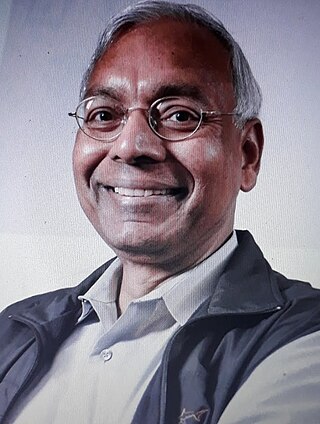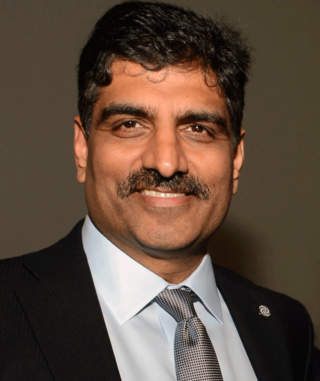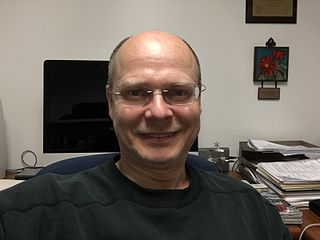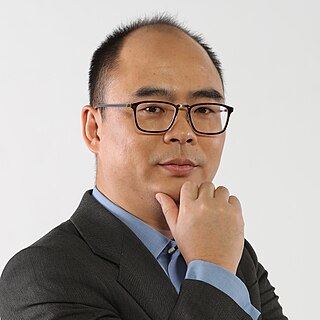Robert M. Haralick is Distinguished Professor in Computer Science at Graduate Center of the City University of New York (CUNY). Haralick is one of the leading figures in computer vision, pattern recognition, and image analysis. He is a Fellow of the Institute of Electrical and Electronics Engineers (IEEE) and a Fellow and past president of the International Association for Pattern Recognition. Professor Haralick is the King-Sun Fu Prize winner of 2016, "for contributions in image analysis, including remote sensing, texture analysis, mathematical morphology, consistent labeling, and system performance evaluation".

Thomas Shi-Tao Huang was a Chinese-born American computer scientist, electrical engineer, and writer. He was a researcher and professor emeritus at the University of Illinois at Urbana-Champaign (UIUC). Huang was one of the leading figures in computer vision, pattern recognition and human computer interaction.
Ramesh Chandra Jain is a scientist and entrepreneur in the field of information and computer science. He is a Bren Professor in Information & Computer Sciences, Donald Bren School of Information and Computer Sciences, University of California, Irvine.

Linda G. Shapiro is a professor in the Department of Computer Science and Engineering, a professor of electrical engineering, and adjunct professor of Biomedical Informatics and Medical Education at the University of Washington.
Xi-Cheng Zhang is a Chinese-born American physicist, currently serving as the Parker Givens Chair of Optics at the University of Rochester, and the director of the Institute of Optics. He is also the Chairman of the Board and President of Zomega Terahertz Corporation.
Demetri Psaltis is a Greek-American electrical engineer who was the Dean of the School of Engineering at École Polytechnique Fédérale de Lausanne from 2007 to 2017. Since 2024 he is a professor emeritus at EPFL. He is one of the founders of the term and the field of optofluidics. He is also well known for his past work in holography, especially with regards to optical computing, holographic data storage, and neural networks. He is an author of over 1100 publications, contributed more than 20 book chapters, invented more than 50 patents, and currently has a h-index of 105.
Maria Petrou FREng was a Greek-born British scientist who specialised in the fields of artificial intelligence and machine vision. She developed a number of novel image recognition techniques, taught at Surrey University and Imperial College London, and was a prolific author of scientific articles.
Matti Kalevi Pietikäinen is a computer scientist. He is currently Professor (emer.) in the Center for Machine Vision and Signal Analysis, University of Oulu, Finland. His research interests are in texture-based computer vision, face analysis, affective computing, biometrics, and vision-based perceptual interfaces. He was Director of the Center for Machine Vision Research, and Scientific Director of Infotech Oulu.

Anil Kumar Jain is an Indian-American computer scientist and University Distinguished Professor in the Department of Computer Science & Engineering at Michigan State University, known for his contributions in the fields of pattern recognition, computer vision and biometric recognition. He is among the top few most highly cited researchers in computer science and has received various high honors and recognitions from institutions such as ACM, IEEE, AAAS, IAPR, SPIE, the U.S. National Academy of Engineering, the Indian National Academy of Engineering and the Chinese Academy of Sciences.

Venu Govindaraju is an Indian-American whose research interests are in the fields of document image analysis and biometrics. He presently serves as the Vice President for Research and Economic Development. He is a SUNY Distinguished Professor of Computer Science and Engineering, School of Engineering and Applied Sciences at the University at Buffalo, The State University of New York, Buffalo, NY, USA.
Fractal expressionism is used to distinguish fractal art generated directly by artists from fractal art generated using mathematics and/or computers. Fractals are patterns that repeat at increasingly fine scales and are prevalent in natural scenery. Fractal expressionism implies a direct expression of nature's patterns in an art work.

Wolfgang Fink is a German-American theoretical physicist. He is currently an associate professor and the inaugural Maria & Edward Keonjian Endowed Chair of Microelectronics at the University of Arizona. Fink has joint appointments in the Departments of Electrical & Computer Engineering, Biomedical Engineering, Systems & Industrial Engineering, Aerospace & Mechanical Engineering, and Ophthalmology & Vision Science at the University of Arizona. He is the current Vice President of the Prognostics and Health Management (PHM) Society.

René Vidal is a Chilean electrical engineer and computer scientist who is known for his research in machine learning, computer vision, medical image computing, robotics, and control theory. He is the Herschel L. Seder Professor of the Johns Hopkins Department of Biomedical Engineering, and the founding director of the Mathematical Institute for Data Science (MINDS).

Yong Rui is the chief technology officer and senior vice president of Lenovo Group. He is in charge of Lenovo's technical strategy, research and development directions, and Lenovo Research, one of Lenovo's most important innovation engines.

Gang Hua is a Chinese-American computer scientist who specializes in the field of computer vision and pattern recognition. He is an IEEE Fellow, IAPR Fellow and ACM Distinguished Scientist. He is a key contributor to Microsoft's Facial Recognition technologies.

Georgia "Gina" D. Tourassi is the Director of the Oak Ridge National Laboratory health data sciences institute and adjunct Professor of radiology at Duke University. She works on biomedical informatics, computer-aided diagnosis and artificial intelligence (AI) in health care.
Jiebo Luo is a Chinese-American computer scientist, the Albert Arendt Hopeman Professor of Engineering and Professor of Computer Science at the University of Rochester. He is interested in artificial intelligence, data science and computer vision.

Michael Bronstein is an Israeli computer scientist and entrepreneur. He is a computer science professor at the University of Oxford.
Ramalingam "Rama" Chellappa is a Bloomberg Distinguished Professor, who works at Johns Hopkins University. At Johns Hopkins University, he is a member of the Center for Language and Speech Processing, the Center for Imaging Science, the Institute for Assured Autonomy, and the Mathematical Institute for Data Sciences. He joined Johns Hopkins University after 29 years at The University of Maryland. Before that, he was an assistant, associate professor, and later, director, of the University of Southern California's Signal and Image Processing institute.
Ge Wang is a medical imaging scientist focusing on computed tomography (CT) and artificial intelligence (AI) especially deep learning. He is the Clark & Crossan Chair Professor of Biomedical Engineering and the Director of the Biomedical Imaging Center at Rensselaer Polytechnic Institute, Troy, New York, USA. He is known for his pioneering work on CT and AI-based imaging. He is Fellow of American Institute for Medical and Biological Engineering (AIMBE), Institute of Electrical and Electronics Engineers (IEEE), International Society for Optics and Photonics (SPIE), Optical Society of America (OSA/Optica), American Association of Physicists in Medicine (AAPM), American Association for the Advancement of Science (AAAS), and National Academy of Inventors (NAI).










